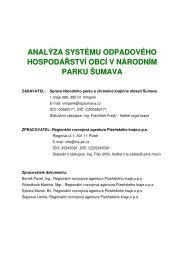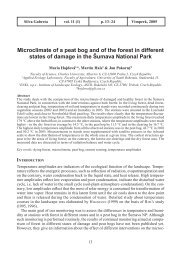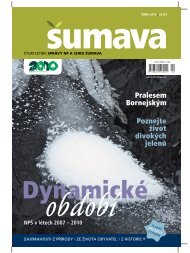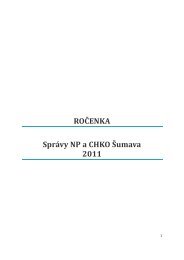Algae, Cyanobacteria and Chytridiales of Černé Lake in the ...
Algae, Cyanobacteria and Chytridiales of Černé Lake in the ...
Algae, Cyanobacteria and Chytridiales of Černé Lake in the ...
Create successful ePaper yourself
Turn your PDF publications into a flip-book with our unique Google optimized e-Paper software.
HI 100/1.25 or 40/0.95 objectives, <strong>the</strong>n pencilled or photographed us<strong>in</strong>g MA8 film with a<br />
BA-1 automatic exposure unit (Zeiss, Jena, Germany). Bacillariophyceae were prepared by<br />
boil<strong>in</strong>g with H 2 O 2 , with a spike <strong>of</strong> K 2 Cr 2 O 7 , <strong>and</strong> mounted <strong>in</strong>to Pleurax (<strong>of</strong> our own production),<br />
or alternatively used for transmission electron microscopy: specimens were fixed <strong>in</strong> 3%<br />
glutaraldehyde <strong>in</strong> 0,1 M phosphate buffer (pH 7.2) <strong>and</strong> postfixated by 1% osmium tetroxide.<br />
After several washes <strong>and</strong> dehydratation through alcohol series, samples were embedded <strong>in</strong><br />
Spurr res<strong>in</strong> (Polysciences Inc.). Ultrath<strong>in</strong> sections were cut on ultramicrotome (Leica UCT),<br />
successively sta<strong>in</strong>ed by lead citrate <strong>and</strong> uranyl acetate, <strong>and</strong> f<strong>in</strong>aly exam<strong>in</strong>ed <strong>in</strong> transmission<br />
electron microscope JEM1010 (JEOL, Japan) equipped with a CCD camera MegaWiev III<br />
(SIS Germany). For scann<strong>in</strong>g electron microscopy (SEM) <strong>the</strong> specimens were fixed by 2.5%<br />
glutaraldehyde <strong>in</strong> 0.1 M potassium phosphate buffer (pH 7.2), postfixed by 1% osmium tetroxide<br />
<strong>in</strong> <strong>the</strong> same buffer, dehydrated through a graded acetone series <strong>and</strong> dried <strong>in</strong> <strong>the</strong> critical<br />
po<strong>in</strong>t drier Pelco CPD2. Then <strong>the</strong> samples were coated with gold <strong>and</strong> exam<strong>in</strong>ed with<br />
scann<strong>in</strong>g electron microscope JEOL 6300 (Japan).<br />
<strong>Algae</strong> <strong>and</strong> <strong>Chytridiales</strong> were determ<strong>in</strong>ed by us<strong>in</strong>g <strong>the</strong> monographs <strong>of</strong> SPARROW (1960),<br />
HUBER-PESTALOZZI (1961, 1962), FOTT (1962), SIEMINSKA (1964), STARMACH (1966, 1968a,b),<br />
BATKO (1975), HINDÁK (1978), ETTL (1983), <strong>and</strong> KOMÁREK & FOTT (1983). Both some unpublished<br />
results <strong>and</strong> draw<strong>in</strong>gs were taken from <strong>the</strong> field notebook <strong>of</strong> B. FOTT (unpubl. data).<br />
RESULTS AND DISCUSSION<br />
The list <strong>of</strong> <strong>the</strong> algae determ<strong>in</strong>ed <strong>in</strong> <strong>Černé</strong> <strong>Lake</strong> is <strong>in</strong> Table 1 (documented <strong>in</strong> Figs. 1–20).<br />
There are altoge<strong>the</strong>r 422 species, <strong>in</strong>clud<strong>in</strong>g <strong>the</strong> lake wall (a stony slope ris<strong>in</strong>g above <strong>the</strong> lake)<br />
<strong>and</strong> sediment core, 260 species were recent. Only 17 were planktonic, 75 species were found<br />
as subaerophytes <strong>in</strong> <strong>the</strong> lake wall. The majority <strong>of</strong> algal species <strong>of</strong> <strong>the</strong> lake occured <strong>in</strong> <strong>the</strong><br />
benthos (90 species, Table 2). A similar proportion between <strong>the</strong> phytoplankton <strong>and</strong> benthos<br />
was found <strong>in</strong> <strong>the</strong> o<strong>the</strong>r lakes <strong>of</strong> <strong>the</strong> Bohemian Forest area, <strong>in</strong>clud<strong>in</strong>g <strong>the</strong> lakes <strong>of</strong> <strong>the</strong> Bavarian<br />
Forest (WEILNER 1997).<br />
The species richness (Table 3) <strong>of</strong> <strong>Algae</strong> <strong>and</strong> <strong>Cyanobacteria</strong> <strong>of</strong> mounta<strong>in</strong> lakes is generally<br />
controlled by altitude. The species richness <strong>of</strong> phytoplankton <strong>in</strong> <strong>the</strong> High Tatra Mts. lakes<br />
was 2–13, <strong>and</strong> <strong>in</strong>versely related to altitudes <strong>of</strong> 1300–2200 m a.s.l. (LUKAVSKÝ 1994); <strong>the</strong> total<br />
number <strong>of</strong> species was 161 (JURIŠ & KOVÁČIK 1987). SANCHES-CASTILLO (1988) evaluated <strong>the</strong><br />
algal flora <strong>of</strong> lakes <strong>in</strong> <strong>the</strong> Sierra Nevada (Spa<strong>in</strong>), at altitudes <strong>of</strong> 2500–3000 m, <strong>and</strong> found up<br />
to 149 taxa; STARMACH (1973) studied algae <strong>in</strong> <strong>the</strong> largest lake, Wielki Staw, <strong>in</strong> <strong>the</strong> Polish<br />
High Tatra Mts., where species richness was 140 taxa. NEDBALOVÁ (2001) found 30 common<br />
species <strong>of</strong> phytoplankton <strong>in</strong> 7 lakes <strong>of</strong> <strong>the</strong> Bohemian Forest, LEDERER & LUKAVSKÝ (2001),<br />
LUKAVSKÝ <strong>in</strong> WEILNER (1997) evaluated <strong>the</strong> species richness <strong>of</strong> 3 lakes <strong>in</strong> <strong>the</strong> Bavarian side<br />
<strong>of</strong> <strong>the</strong> Bohemian Forest to be from 36–106. <strong>Černé</strong> <strong>Lake</strong>, with 260 species <strong>of</strong> algae <strong>and</strong> cyanobacteria,<br />
is a prom<strong>in</strong>ent locality.<br />
The taxonomy aff<strong>in</strong>ity is not easy to compare because <strong>of</strong> different taxonomy systems, as<br />
well as <strong>the</strong> different specialisations <strong>and</strong> aims <strong>of</strong> <strong>the</strong> authors. However, rough comparisons<br />
are possible (Table 4). With respect to species richness, <strong>Černé</strong> <strong>Lake</strong> is <strong>the</strong> richest lake <strong>in</strong> <strong>the</strong><br />
Bohemian Forest, followed by Grosser Arbersee, Kle<strong>in</strong>er Arbersee, <strong>and</strong> Rachelsee (<strong>the</strong> poorest);<br />
results for Laka <strong>Lake</strong> <strong>and</strong> Prášilské <strong>Lake</strong> have not yet been completed <strong>and</strong> published.<br />
Benthic diatoms better reflect <strong>the</strong> changes <strong>in</strong> <strong>the</strong> environment <strong>of</strong> lakes than phytoplankton,<br />
<strong>and</strong> represent a prom<strong>in</strong>ent tool for <strong>the</strong> evaluation <strong>of</strong> water quality (WHITTON & ROTT<br />
1996). <strong>Černé</strong> <strong>Lake</strong> was worked up by STEINICH <strong>in</strong> FRIČ & VÁVRA (1897), who determ<strong>in</strong>ed diatoms<br />
on <strong>the</strong> surface <strong>of</strong> mud from water depths <strong>of</strong> 30–35 m, <strong>and</strong> listed <strong>the</strong>m along with excellent<br />
draw<strong>in</strong>gs (Fig. 11), so we are now better able to compare <strong>the</strong>m.<br />
4



![Zima 2008 [4MB] - Národní park Šumava](https://img.yumpu.com/21236024/1/184x260/zima-2008-4mb-narodni-park-sumava.jpg?quality=85)






